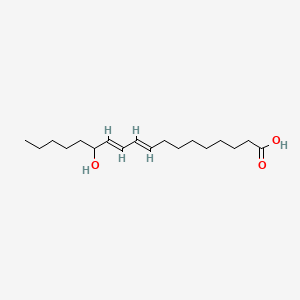| MeSH term | MeSH ID | Detail |
|---|---|---|
| Zellweger Syndrome | D015211 | 39 associated lipids |
| Adenomatous Polyposis Coli | D011125 | 16 associated lipids |
| Adenomatous Polyps | D018256 | 4 associated lipids |
alpha-artemisic acid
Alpha-artemisic acid is a lipid of Fatty Acyls (FA) class.
Cross Reference
There are no associated biomedical information in the current reference collection.
Current reference collection contains 1126 references associated with alpha-artemisic acid in LipidPedia. Due to lack of full text of references or no associated biomedical terms are recognized in our current text-mining method, we cannot extract any biomedical terms related to diseases, pathways, locations, functions, genes, lipids, and animal models from the associated reference collection.
Users can download the reference list at the bottom of this page and read the reference manually to find out biomedical information.
Here are additional resources we collected from PubChem and MeSH for alpha-artemisic acid
Possible diseases from mapped MeSH terms on references
We collected disease MeSH terms mapped to the references associated with alpha-artemisic acid
NCBI Entrez Crosslinks
All references with alpha-artemisic acid
Download all related citations| Authors | Title | Published | Journal | PubMed Link |
|---|---|---|---|---|
| Jira W et al. | Strong increase in hydroxy fatty acids derived from linoleic acid in human low density lipoproteins of atherosclerotic patients. | 1998 | Chem. Phys. Lipids | pmid:9488997 |
| Nagy L et al. | Oxidized LDL regulates macrophage gene expression through ligand activation of PPARgamma. | 1998 | Cell | pmid:9568715 |
| Stepień K et al. | Reduction of 13-hydroperoxy-9,11-octadecadienoic acid by dopamine-melanin. | 1998 | Biochem. Biophys. Res. Commun. | pmid:9535742 |
| Buchanan MR et al. | Regulation of endothelial cell and platelet receptor-ligand binding by the 12- and 15-lipoxygenase monohydroxides, 12-, 15-HETE and 13-HODE. | 1998 | Prostaglandins Leukot. Essent. Fatty Acids | pmid:9690711 |
| Neuzil J et al. | Secretory phospholipase A2 and lipoprotein lipase enhance 15-lipoxygenase-induced enzymic and nonenzymic lipid peroxidation in low-density lipoproteins. | 1998 | Biochemistry | pmid:9636068 |
| Spindler S and Reddy RG | Effect of pH on enzyme immunoassay and analysis of urine. | 1998 | Am Clin Lab | pmid:10345154 |
| Hill EM et al. | Differentiation dependency of eicosanoid enzyme expression in human tracheobronchial cells. | 1998 | Toxicol. Lett. | pmid:9820673 |
| Murthy S et al. | 13-hydroxy octadecadienoic acid (13-HODE) inhibits triacylglycerol-rich lipoprotein secretion by CaCo-2 cells. | 1998 | J. Lipid Res. | pmid:9643357 |
| Pomposiello SI et al. | Linoleic acid induces relaxation and hyperpolarization of the pig coronary artery. | 1998 | Hypertension | pmid:9461230 |
| Kang LT and Vanderhoek JY | Mono (S) hydroxy fatty acids: novel ligands for cytosolic actin. | 1998 | J. Lipid Res. | pmid:9684751 |
| Mani I et al. | Upregulation of nuclear PKC and MAP-kinase during hyperproliferation of guinea pig epidermis: modulation by 13-(S)-hydroxyoctadecadienoic acid (13-HODE). | 1998 | Cell. Signal. | pmid:9481490 |
| Chen NG et al. | PPARgamma agonists enhance human vascular endothelial adhesiveness by increasing ICAM-1 expression. | 1999 | Biochem. Biophys. Res. Commun. | pmid:10512746 |
| Jang MK et al. | Regulation of ferritin light chain gene expression by oxidized low-density lipoproteins in human monocytic THP-1 cells. | 1999 | Biochem. Biophys. Res. Commun. | pmid:10558912 |
| Friedrichs B et al. | 13-HPODE and 13-HODE modulate cytokine-induced expression of endothelial cell adhesion molecules differently. | 1999 | Biofactors | pmid:10221158 |
| Truitt A et al. | Antiplatelet effects of conjugated linoleic acid isomers. | 1999 | Biochim. Biophys. Acta | pmid:10320806 |
| Pongracz J and Lord JM | The lipoxygenase product 13-hydroxyoctadecadienoic acid (13-HODE) is a selective inhibitor of classical PKC isoenzymes. | 1999 | Biochem. Biophys. Res. Commun. | pmid:10079174 |
| Sauer LA et al. | 13-Hydroxyoctadecadienoic acid is the mitogenic signal for linoleic acid-dependent growth in rat hepatoma 7288CTC in vivo. | 1999 | Cancer Res. | pmid:10493526 |
| Blask DE et al. | Melatonin inhibition of cancer growth in vivo involves suppression of tumor fatty acid metabolism via melatonin receptor-mediated signal transduction events. | 1999 | Cancer Res. | pmid:10493527 |
| Dauchy RT et al. | Dim light during darkness stimulates tumor progression by enhancing tumor fatty acid uptake and metabolism. | 1999 | Cancer Lett. | pmid:10529012 |
| Blackburn ML et al. | Specific protein targets of 13-oxooctadecadienoic acid (13-OXO) and export of the 13-OXO-glutathione conjugate in HT-29 cells. | 1999 | Biochim. Biophys. Acta | pmid:10521706 |
